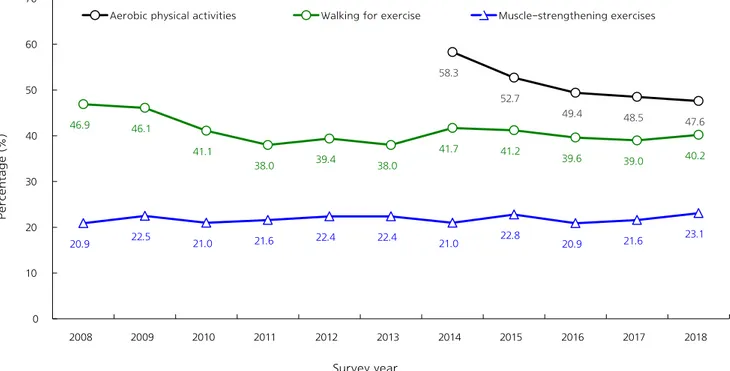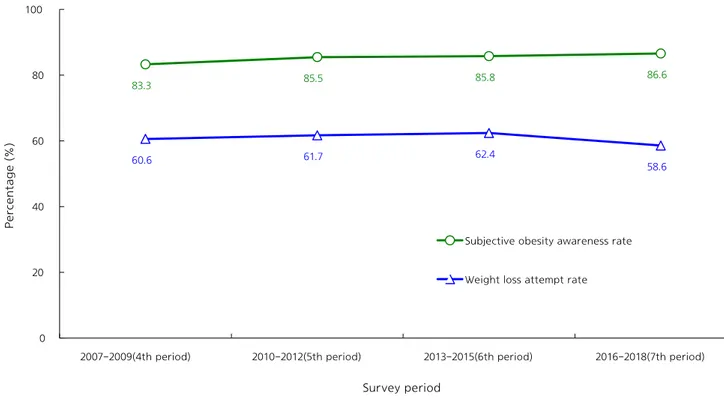www.cdc.go.kr
1037
주간 건강과 질병•제13권 제16호만성질환 통계
1. 신체활동 실천율 추이, 2008∼2018
◈
만 19세 이상 유산소신체활동 실천율은 2014년 58.3%에서 2018년 47.6%로 10.7%p 감소하였고, 2018년 기준 10명 중 4.8명만이
유산소신체활동을 하는 것으로 나타났음. 걷기 실천율은 2008년 46.9%에서 2018년 40.2%로 6.7%p 감소하였음(그림 1).
58.3 52.7 49.4 48.5 47.6 46.9 46.1 41.1 38.0 39.4 38.0 41.7 41.2 39.6 39.0 40.2 20.9 22.5 21.0 21.6 22.4 22.4 21.0 22.8 20.9 21.6 23.1 0 10 20 30 40 50 60 70 2008 2009 2010 2011 2012 2013 2014 2015 2016 2017 2018 실 천 율 (% ) 조사년도 유산소신체활동 걷기 근력운동그림 1. 신체활동 실천율 추이, 2008∼2018
* 유산소신체활동 실천율 : 일주일에 중강도 신체활동을 2시간 30분 이상 또는 고강도 신체활동을 1시간 15분 이상 또는 중강도와 고강도 신체활동을 섞어서(고강도 1분은 중강도 2분) 각 활동에 상당하는 시간을 실천한 분율 † 걷기 실천율 : 최근 1주일 동안 걷기를 1회 10분 이상, 1일 총 30분 이상 주 5일 이상 실천한 분율 ‡ 근력운동 실천율 : 최근 1주일 동안 팔굽혀펴기, 윗몸 일으키기, 아령, 역기, 철봉 등의 근력운동을 2일 이상 실천한 분율 ※ 연도별 지표값은 2005년 추계인구로 연령표준화www.cdc.go.kr
1038
주간 건강과 질병•제13권 제16호2. 비만 관리수준(주관적 비만인지율, 체중감소 시도율) 추이, 2007∼2018
◈
만 19세 이상 성인의 주관적 비만인지율(연령표준화)은 2016∼2018년(제7기) 기준 86.6%로, 비만자(체질량지수가 25kg/m
2이상) 10명 중
8.7명은 본인의 체형이 ‘약간비만’ 또는 ‘매우비만’이라고 인지하였으며, 비만자 10명 중 5.9명은 체중을 감소하려고 노력하였음(그림 1).
83.3 85.5 85.8 86.6 60.6 61.7 62.4 58.6 0 20 40 60 80 100 2007~2009(4기) 2010~2012(5기) 2013~2015(6기) 2016~2018(7기) 백 분 율(%) 조사기간 주관적 비만인지율 체중감소 시도율그림 1. 주관적 비만인지율 및 체중감소 시도율 추이, 2007∼2018
* 주관적 비만인지율 : 체질량지수 25kg/m2 이상인 사람 중 본인의 체형이 “약간비만” 또는 “매우비만”이라고 생각하는 분율, 만 19세 이상 †체중감소 시도율 : 체질량지수 25kg/m2 이상인 사람 중 최근 1년간 본인의지로 체중을 감소하려고 노력했던 분율, 만 19세 이상 ‡연도별 지표값은 2005년 추계인구로 연령표준화 § 2007∼2009년, 2010∼2012년, 2013∼2015년, 2016∼2018년 통합하여 통계치 산출 출처: 2018년 국민건강통계, http://knhanes.cdc.go.kr/ 작성부서: 질병관리본부 질병예방센터 만성질환관리과www.cdc.go.kr
1039
주간 건강과 질병•제13권 제16호Noncommunicable Disease (NCD) Statistics
1. Trends in rate of physical activity, 2008-2018
◈
The age-standardized rate of Korea adults aged 19 years and over who performed aerobic physical activity had been on the
decrease, from 58.3% in 2014 to 47.6% in 2018 (a reduction of 10.7 percentage points). Based on the 2018 data, only 4.8 out of 10 people
were found to perform aerobic physical activity for exercise. In addition, the rate of adults who walked for exercise had also declined from
46.9% in 2008 to 40.2% in 2018 (a reduction of 6.7 percentage points), indicating that 4 out of 10 adults were walking for exercise (Figure 1).
58.3 52.7 49.4 48.5 47.6 46.9 46.1 41.1 38.0 39.4 38.0 41.7 41.2 39.6 39.0 40.2 20.9 22.5 21.0 21.6 22.4 22.4 21.0 22.8 20.9 21.6 23.1 0 10 20 30 40 50 60 70 2008 2009 2010 2011 2012 2013 2014 2015 2016 2017 2018 P e rc e n ta g e ( % ) Survey year
Aerobic physical activities Walking for exercise Muscle-strengthening exercises
Figure 1. Rate of physical activity among Korean adults aged 19 years and over, 2008-2018
* Rate of aerobic physical activity: percentage of people who spent time corresponding to each activity; more than 2 1/2 hours of moder-ate-intensive physical activity a week or more than 1 hour and 15 minutes of high-intensity physical activity a week or mixing moderate and high-intensive physical activity (1 minute of high-intensity is equivalent for 2 minutes of moderate-intensity)
† Rate of people who walked for exercise: percentage of people who walked for exercise, for more than 10 minutes each time, more than 30 minutes each day, 5 days or more per week, over the past 1 week.
‡ Rate of people who performed muscle-strengthening exercises: percentage of people who performed muscle-strengthening exercises such as push-ups, sit-ups, or other weight-bearing exercises using dumbbell, barbell or pull-up bars, etc, for 2 days or more per week, for the past 1 week
www.cdc.go.kr
1040
주간 건강과 질병•제13권 제16호2. Subjective obesity awareness rate and Weight loss attempt rate, 2007-2018
◈
The subjective obesity rate (age standardization) for adults aged 19 and over was 86.6% as of 2016-2018 (the 7
thperiod). 8.7 out of
10 obese people (the BMI 25kg/m
2or more) perceived their body type as 'lightly obese' or 'very obese' and 5.9 out of 10 tried to lose
weight (Figure. 1).
83.3 85.5 85.8 86.6 60.6 61.7 62.4 58.6 0 20 40 60 80 1002007-2009(4th period) 2010-2012(5th period) 2013-2015(6th period) 2016-2018(7th period)
P e rc e n ta g e ( % ) Survey period
Subjective obesity awareness rate
Weight loss attempt rate
Figure 1. Subjective obesity awareness rate and Weight loss attempt rate, 2007-2018
* Subjective obesity awareness rate : percentage of people with a BMI 25kg/m2 or more, among those aged 19 years over who think their
body type is “slightly obese” or “very obese”.
† Weight loss attempt rate : percentage of people with a BMI 25kg/m2 or more, among those aged 19 years over who have tried to lose
weight by themselves over the past year.
‡The mean in figure 1 was calculated using the direct standardization method based on a 2005 population projection. § Calculate statistics by combining 2007-2009, 2010-2012, 2013-2015, 2016-2018
Source:Korea Health Statistics 2018, Korea National Health and Nutrition Examination Survey, http://knhanes.cdc.go.kr/ Reportedby:Division of Chronic Disease Control, Korea Centers for Disease Control and Prevention

